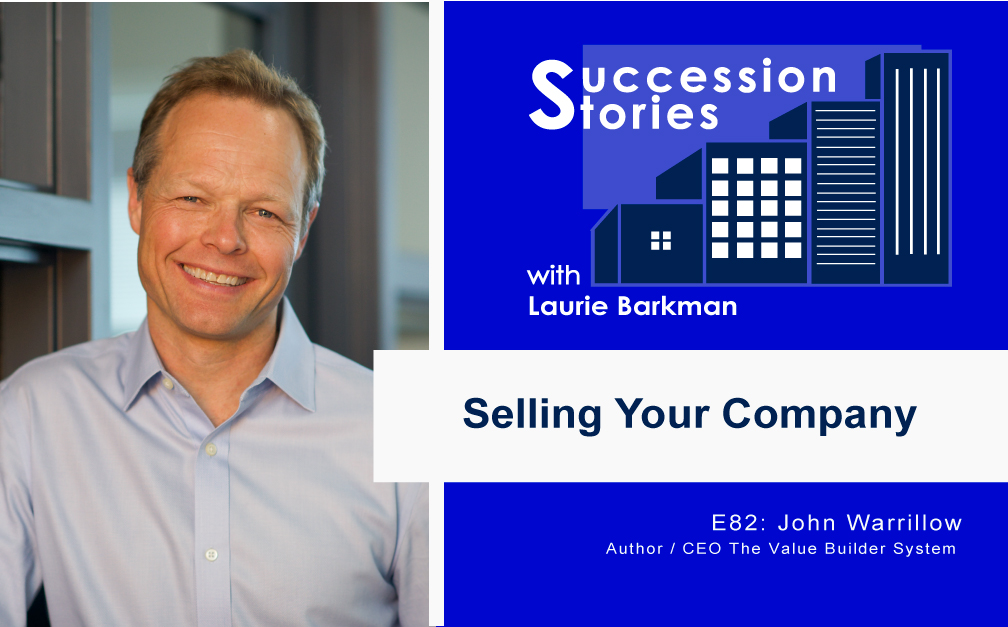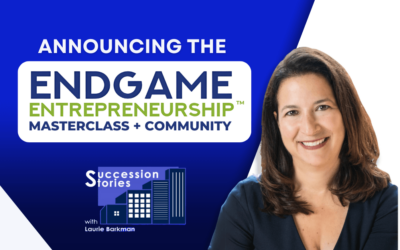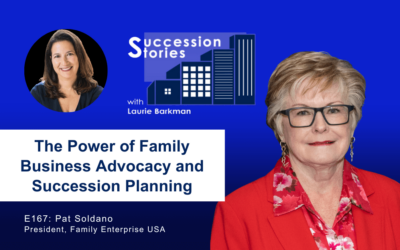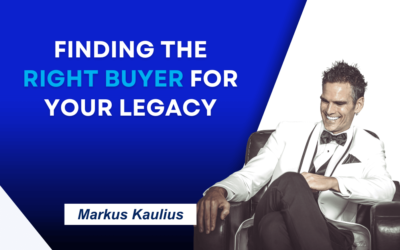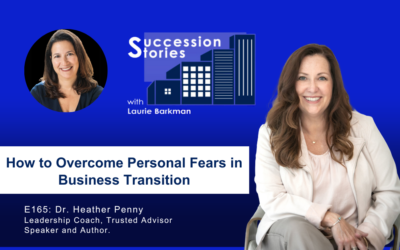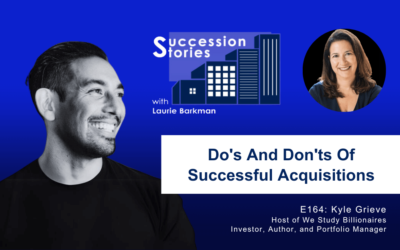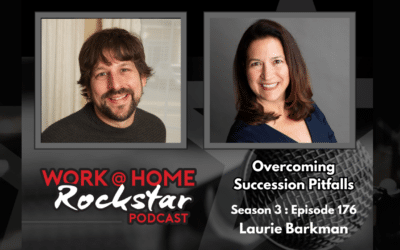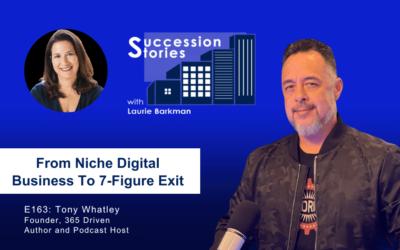Host Laurie Barkman talks with John Warrillow, best selling author of Built to Sell, Built to Sell Radio, and Founder of The Value Builder System, a company that provides business owners with a proven process for improving value and preparing for an exit. Prior to starting Value Builder, John started and exited four companies. John shares relatable stories – including his own – about personal readiness and having blind spots for the potential value of your business. John shares practical steps business owners should take to maximize the value of their business, and protect their business in both the short and long term. If you think you might sell your company one day, or want to know that you can, this is a great episode to dig into.
Listen in to learn more about:
- John’s entrepreneur’s journey and what inspired The Value Builder System
- Why a company that isn’t transferable is worthless.
- What drives the value of your business, and what you can do to prepare personally
- Finding out what your business is worth to see if you have a gap
- Common answers to the question, “What’s the biggest obstacle you’re facing in transitioning your company in the future?”
- Some of the biggest mistakes business owners make when they go to sell.
- How to find the right buyer for your business, working with a broker or intermediary versus on your own.
Show Links:
- BuiltToSell.com
- The Value Builder System website: www.valuebuildersystem.com
- Personal Readiness to Exit assessment: getmyprescore.com
- Value Builder exit value assessment: getmyvbscore.com
- The Overlooked Owner eBook: https://bit.ly/overlooked_owner
Don’t leave your exit to chance.
Stony Hill Advisors works with owners like you to get ready and maximize value when you’re ready to sell.
Visit www.stonyhilladvisors.com/podcast for a complimentary business valuation.
About Succession Stories Podcast
Succession Stories is hosted by Laurie Barkman, the Business Transition Sherpa– guiding business owners through the process from “transition to transaction.”
Learn more at https://thebusinesstransitionsherpa.com
Book a 1:1 Advisory call: meetlauriebarkman.com or lbarkman@smalldotbig.com
Transcript
Intro:
John Warrillow may be a familiar name if you’ve read Built to Sell, The Art of Selling Your Business, or listen to his podcast, Built to Sell Radio. John is the Founder of The Value Builder System, a company that provides business owners with a proven process for improving value and preparing for an exit. As a certified Value Builder Advisor, it was a thrill to talk with John about his experience as an entrepreneur. Prior to starting The Value Builder System, John started and exited four companies. I would say today’s episode with John is truly one of my favorites, a mini-masterclass with relatable stories – including his own – about personal readiness and having blind spots for the potential value of your business. If you think you might sell your company one day, this is a great episode to dig into with John Warrillow.
Laurie Barkman:
John Warrillow, it is my pleasure to have you on Succession Stories today.
John Warrillow:
It’s good to be with you, Laurie.
Laurie Barkman:
I’ve wanted to have you on the show for a while. We met when I was going through the Value Builder Program.
John Warrillow:
That’s right.
Laurie Barkman:
I was fortunate in that you were the instructor, which I think you had said at the time was your last instructor class, so —
John Warrillow:
The swansong.
Laurie Barkman:
I caught you at just the right moment.
John Warrillow:
We should be clear because we brought in a head coach, not because we stopped doing certified value, but we brought in a head coach, and yeah, it was my last time doing it.
Laurie Barkman:
You were a great instructor so we’ll certainly talk about the Value Builder System in a moment. I’m also a huge fan of your podcast, Built to Sell Radio, and I listen to it quite a bit. You, I believe, are an entrepreneur’s entrepreneur, you’ve started and exited four companies and now you’ve created — a few years ago — you’ve created this new company called the Value Builder System, and in a great way you are paying it forward, so again, welcome.
John Warrillow:
Thanks, Laurie.
Laurie Barkman:
Let’s start with you and your journey. What inspired you to launch the value Builder System?
John Warrillow:
Well, it goes back years ago, I used to run a quantitative market research business, and I had — no, we had some great clients; big big banks and phone companies – PNC Bank, actually near where you are. It was a big, big client of ours and I got thinking we were about 5 million in sales, 30 employees or something like that, we had good profits, 20-30% profit margins and I got the idea that I wanted to sell the company. I went to an advisor named Perry Miele, I’ll never forget, he’s in Toronto and I was obviously curious to know what it was worth and he said, “Okay, before I answer that, let me ask you a couple questions.” I said, “Shoot.” “So, well, who does the research?” I’m like, “Well, I’m involved in some of the research. These are big banks, ‘course I’ve got to show up.” Then he said, “Well, who does the selling?” And I said, “So it’s PNC Bank, of course, I’ve got to go do that, I’ve got to be there.” He’s like, “John, I don’t have to tell you this, but I can’t sell your company, there’s nothing to sell, it’s worthless,” and it was like a gut punch for me, because he was telling me something I didn’t want to hear.
I thought I had a valuable business because I had great clients, because we made lots of profit and revenue. None of that, of course, is worth anything to an acquirer if it’s not possible to recreate without the owner. Perry pointed that out to me and in no uncertain terms and so to his credit, he worked with me over a bunch of years, to sort of point out how to transform the company.
We created recurring revenue, we hired salespeople… ultimately went on to be sold by a publicly traded company in New York Stock Exchange listed company so it had sort of had a happy ending, but it left me really sort of scarred by just how naive I was to what drove value. In part, that was why I wanted to write the book Built to Sell and it’s also what inspired us to start Value Builder – just try to to help owners really think about what it is that makes their company valuable and kind of dispel some of the myths that we all kind of grew up thinking it’s going to make our companies valuable.
Laurie Barkman:
That’s a great story, because it had a happy ending but you’re thankful, I’m sure for that journey and I can appreciate the Value Builder System just so we can talk a moment about the system in a little more detail. I am a Certified Value Builder Advisor, I do talk about the platform on the show, but since you’re here, it’s a great opportunity to just add a little more color, what is the system? What do our advisors do, generally speaking?
John Warrillow:
Yeah, for sure, so this system enables you to first of all benchmark where you’re at in terms of the value of your company, and then improve your value over time and so whether you want to sell a year from now, 10 years from now, you can establish what the value of your company is, and then understand how an acquirer would look at your company and understand how you’re performing on these eight factors that acquirers care about. You get a score on each factor, and then as you know, Laurie, you can work with someone like yourself to improve. The owner can work with someone like yourself to improve their score on those eight factors, ultimately making themselves a more valuable company.
What we know, statistically, is people who achieve the average score, I think, on the initial intake questionnaire is 59, out of a possible 100 and so those companies on average are trading at about 3.5 times the pre-tax profit, so pretty average mold. Those businesses that go through the Value Builder system and improve their score up to a score of 90 or greater, these are sort of the best, all stars. Those businesses are getting offers of 7.1 times pre-tax profit or more than double when they started with us, so we know that this works. It also almost triples the likelihood that you’re going to get a written offer.
Again, for people who don’t want to sell your business, they may be like, “Well, why do I care about that?” The reason I think you care about that, is that it gives you a negotiating leverage. When you’re being courted, it gives you all of the cards at the poker table. You can choose to not engage or engage, but dictate your terms and so that just gives you so much more power in the negotiation process so I think whether you want to sell your business a year from now, or 20 years from now, at least working with you to get benchmarked on where they’re at, I think is a really key key thing to do.
Laurie Barkman:
That’s a great segue, we’re going to talk about readiness from a couple of different aspects. The first one that’s super important is personal readiness and your story, you talked about the business being ready. What if you yourself as the owner are not ready, and what the motivations are, along that spectrum?
John Warrillow:
What’s interesting is the Exit Planning Institute came up with a stat a couple years ago, and they apparently did a survey of people a year after selling their company, and they discovered that three quarters of business owners after selling, had some regret about their sale and I mean, people when they hear that are going to be blown away. I think I was blown away, because I was like, “How could you? This should be the happiest day of your life. I mean, you have some big fantastic exit,” and in reality, while that’s true, if you’re not personally ready for what’s to come, it can be quite destabilizing, even to the point where you have regrets over it.
We talk about, in PREScore, which again, folks can get through you. You are a Certified Value Builder in their market, you can get a benchmark on these four factors that are important to really think through before you go to sell, probably the most important of which is this thing called your pull factors. Everybody talks about things that frustrate them about their business, right, the pandemic, taxes, regulation, those are all what we refer to as push factors, right? Those are things pushing you to want to sell and most owners get pushed. Something happens and they get pushed into wanting to sell.
The happiest owners, the ones that look back after a year with nothing but happiness and satisfaction are the ones that are more pull than push, so what do I mean by pull? I mean, they’ve thought through what they want to go and do next. You know, I do this podcast, Built to Sell Radio, right, and interview entrepreneurs every week and say, like, “What was it like to sell your company?”
I remember I interviewed this guy named Shawn – I shall never forget – based in Denver, Colorado, and Shawn had built a little IT services company, not a very big company, a couple million in revenue by memory recalls, and in kind of 10 or 12% profit margins, like a fairly ordinary middle America business, nothing terribly dramatic, etc. He woke up on his 39th birthday and he said, “I’m sick of living in landlocked Denver, I want to live on a sailboat. I’ve always dreamt of living on a sailboat,” and so he comes to the realization he’s got to sell his company so he hires a broker. The broker goes away and says, “Look, Shawn, I think we can get you two to three times SDE, which is an expression of profit, and Shawn says, “Fine, but here’s the deal, you got to get it to me before my 40th birthday,” so the broker agrees, goes off gets an offer. And I think it was like 2.6 times pre-tax profit, and Shawn agreed.
I talked to him after the fact because I interviewed him for the show and I said, “So you know, Shawn, I mean, 2.6 times, it’s like, that’s a decent exit, but it’s not life changing.” He said, “But yeah, John, you’re missing the point.” I’m like, “Okay, well, what’s the point?” He’s like, “I live on a sailboat.”
For me, it was a good reminder that someone who has a really clear pull factor, something they want to go do, is very rarely going to regret their decision to sell their company, regardless of whether they make off like a bandit, or get a relatively average multiple, so look, I’m all about building value, I named a company out of it, so I think everyone should do whatever they can to build the value of your company. That being said, thinking through what you want to go and do next, I think is one of the most important steps you can take to make sure you don’t regret your decision to sell and that’s one of the four factors that we measure through PREScore.
Laurie Barkman:
That’s a great story, it does give the sense of how important it is to set goals for what you want to do next and I love talking about pull factors and push factors with folks, it does tend to resonate. When I do workshops with CEOs, I ask a very general question at the start of the workshop, which is, “If I say the word transition, what comes to mind for you?”, and I write down all the words, and then I look at, “Do those words have a positive, neutral or negative association?”, and I feel that there’s a similarity there with the personal readiness side, right, the negative or the positive, can influence, ultimately, the outcome and there’s a great ebook that we have at our disposal from Value Builder, which is called The Overlooked Owner, and I’m happy to share that with the audience. In that I think there’s some measurement around these factors too, the more positive, and also including neutral, meaning not negative; negative will be a detractor, but otherwise, if an owner is part of the process to work on those factors for the business, it’s actually also helping build the value of the business, because they’re recognizing some of these drivers are around them. As you told your story that you can’t have a non-transferable business – it’s going to have less, less inherently less value.
John Warrillow:
Yeah, no, absolutely. It’s funny when you said the word transition, the image that immediately came to mind for me, as an audience of one was the 400 meter race, whatever that is in the Olympics, where they run 100 meters, and they hand the baton off to the next runner. I think that for a lot of entrepreneurs, when they think of transitioning their business, that’s what they think of right, they sprint as far and fast as they possibly can and when they’re exhausted, can’t move a minute longer, they pass the baton to a new owner. That’s, I think, at least that’s the way I thought selling a company was and I think that’s where a lot of owners who haven’t gone through the process yet, think of selling.
What I have found, and going back to the PREScore research is that if you approach an acquirer or an acquirer approaches you and your position is, “Look, I’m going to hand you the keys, and I don’t want to have anything to do with this business ever again,” you’re going to dramatically reduce the audience of people that will want to buy your company, right, because if you think about it from their perspective, they want to monetize what you’ve built and they may need you to help them do that through the form of an earnout, or some sort of what they refer to as a vendor take back where you agree to finance part of the purchase for the acquirer or just as a consultant. If a private equity group were to buy your business, they might want you to carry some equity and again, all these things you can decide whether you’re willing to go down those roads, once you have those offers.
The mistake I see owners make is they close themselves off to those options and say, “No, I want 100% cash up front,” which is fine, that may be what you want, but ironically, the best way to get that is to stay open to lots of different structuring arrangements because once you’re open and signal to the market that you’re open to lots of different structuring, it’s going to increase the number of people that are interested in buying your business, and with more people interested in buying your business, the more you’ll be able to dictate terms. You’ll be able to say, “I know you want me to carry 40% of the equity and I know what you want, half of it in an earnout, but look, we’ve got lots of offers and what I’d really be comfortable with is 10% in an equity carry or 20% or not.” You can dictate those terms to some extent if you’ve got multiple offers and so I think it’s a mistake to think of selling a company as like some sort of relay race where you hand the keys, and then you ride off into the sunset. I think you want to be able to sell early enough in your trajectory, where you can see yourself helping the new owner a year or two, even three years down the road, to help them monetize what they purchase and if you can do that and sell early enough to really feel like you’ve got energy for that, I think you’re just going to maximize your leverage in that negotiation.
Laurie Barkman:
Well, it’s a good point. We have people who are listening who might be in that situation where they’re open to an earnout or they’re open to consulting and staying on in transition, and I work with folks that really want to leave and exit and truly retire. The story about the gentleman from Colorado who wanted to sail, there’s folks that just want to be in the grandparent business or their health is not where it was, COVID has, the pandemic has made a lot of folks just really ready to change gears and switch gears and their definition of wealth has changed and their lifestyle needs are also changing.
I think time is the biggest value we have and I think people are realizing that they might just want to do something different with their time, so my point is that I think in the readiness and time to transition, there’s a spectrum and maybe we’ll just categorize that as ready now, and let’s say that’s a zero to one year, maybe then from there, it’s less than five years, and then maybe less than 10, so if we were going to think about that in terms of business readiness, for business owners that you’ve talked to, and they have this different time horizon, and we ask this question, “What’s the biggest obstacle you’re facing in transitioning your company?” How do you think their answers might change based on their time horizon?
John Warrillow:
Oh, wow, what a great question, and this is something you ask owners?
Laurie Barkman:
I tend to find out and I do hear different things. Getting to know them and getting to know their goals helps me then get grounded and where the conversation goes from there if it’s the first conversation. I’ll just give you one quick example. One of my clients has a 10 year time horizon, so the discussion and the nature of her questions are still very much around growth and around what we would call reducing risk with the Switzerland Structure, so making sure that, in the Switzerland Structure, we have neutrality around customers and employees and suppliers; we don’t have too much risk in any one category. She’s focused on risk reduction, as well as value creation and that’s pretty different, I think, than an owner who’s looking to sell within a year. What’s the biggest obstacle in a transition if I’m 10 years out versus a transition if I’m one year out?
John Warrillow:
I think you want to look at what an acquirer is going to want to evaluate in placing value on your company, and they’re going to want to look at your most recent, trailing 12 months earnings or trailing 12 months revenue, or at least your last fiscal year, maybe two years, three years. They’re gonna want to look at that period of time, and place most emphasis on the last year, but also look at two, three years ago so you can’t remake history, right?
In the one to five year range, I think, maximizing your score on the eight things that we talked about is going to be really important in particular around profitability, unless it’s a technology company that is going to be trading at multiples of revenue, you’re going to be wanting to focus on multiples EBITDA a year out, I mean, people that are within 12 months, I mean, this is where it gets down to this kind of notion of pre-diligence, doing the heavy lifting around, making sure you’ve got all your documents together is going to be important.
I remember I interviewed a couple named Michael Houlihan & Bonnie Harvey, I think are their names. I may be getting it wrong. They’re the founders of Barefoot Winery and if you know the story, Barefoot is a great, great success story – American winery, they got their wine in all the Trader Joe’s in the United States and it’s a huge success story, one of the largest if not the largest independent wine maker in the United States when they decided to sell.
They looked around at the landscape of people that would likely buy their company and, and the most likely strategic acquirer was E & J Gallo, which at the time was the largest wine maker in the United States, part of a large conglomerate, and so they said, “EJ Gallo is the national acquirer,” and so one thing that most people would do at that point is they would sort of reach out to someone at E & J Gallo and say, “Hey, you know we’re maybe making a decision the next 12 months, would you be interested?” And that’s one way to approach it, but they chose a different route. They chose to do all their pre diligence upfront. Pre diligence means getting all your supplier contracts into a binder or virtual data room, getting all your sales information, all your legal documents, your rent, all of the things that you need to demonstrate and due diligence to an acquirer in advance.
I said to Bonnie and Michael, “Why did you do that? I mean, why didn’t you just wait till due diligence and at least you had an offer on the table?” He said, “Well, two reasons. Number one, we wanted the diligence process to be as smooth as possible to make sure that anything that came up would have been handled preemptively.” Fair enough. The second reason though, was I think, brilliant and he said, “The second reason, we put all the binders together and came to E & J Gallo very buttoned up, very polished. In a subtle way it communicated to E & J. Gallo that we were ready for the dance. We were ready for the prom and if they didn’t want to take us to the prom, that was their prerogative, but we were going to the prom,” meaning, “We were going to sell this company and if E & J Gallo chose to drag their feet or not make an offer, the veiled threat without them having to kind of play hardball, the veiled threat was they were going to go to somebody else and I think that is such an important strategy for owners.
It’s not like selling a car or selling a house where you can put it on the market and see what offers to get in and take it back off. Selling a Business is not like that. You do irreparable harm if you try to kind of sell it to test the waters, so to speak, so I think what you want to do is be very, very thoughtful about your pre diligence. When you make the decision to go to market, you want to do your due diligence. Again, it’s going to make everything run much more smoothly but it also is going to communicate to the acquirers that you’re serious and that you’re going to find a buyer and that may be them but it may not be if they’re not interested so I think it’s a really important thing to do and it goes back to your like what do you need to do in that kind of 12 months leading up to a sale? Hire somebody like yourself or an accountant or consultants. Do pre diligence because I think it’s a hugely underlooked strategy – overlooked strategy and I think it can play very well to value your company.
Laurie Barkman:
I like how you describe that and I can say, as a as a intermediary or broker advisor, someone who works with small to medium sized companies to help bring them to market buy side and sell side, both not in the same transaction, of course, but this pre diligence that I like the term, I do that work and so as you were talking, I’m thinking, “Yep, yep, check, check, check,” because guess what? We need all of that information to be able to bring you to market and in a way that showcases all your strengths. Also, we want to know if there are any risks. We don’t want any surprises. No one likes surprises in diligence or negotiation so if there are any things that we want to call out ahead of time, in a way that we’re now owning the narrative, let’s do that. Getting all of the ducks in a row in that manner is really, really important and I like this part of the discussion we’re having, John, because it’s enabling us to transition from this discussion of planning and getting ready for an exit or getting ready for what I call ‘from transition’ now ‘to transaction’ and finding the right buyer having the process I’m holding up for those of you on the YouTube channel, you’ll see the book that we’re talking about, The Art of Selling Your Business that John wrote. Chapter 10 makes me smile, John, you know what chapter 10 is?
John Warrillow:
I don’t have it in front of me, what was chapter 10, you got to remind me.
Laurie Barkman:
I’m going to tell you, as we start to talk about that, and the essence of this book is helping business owners really get ready for selling their company. Some of the elements that John’s already — that you’ve talked about…how to think about the sales transaction process, how to get ready, some of these questions to consider, when’s the best time to sell, and chapter 10, is “Getting Almost Naked.” What this chapter is about is preparing a market document that we call a confidential investment memorandum, or the acronym is a CIM and so now I write a lot of these and so I’m intimately familiar with what a CIM is, and how to, like I said, market this business and so your phrasing made me laugh; getting almost naked, what does that really mean, and tell us in the context of what we’re really doing, which is we’re packaging this business to sell and some of the things that owners are going to want to showcase.
John Warrillow:
Yeah, for sure, so keep in mind where this sits in the process. Usually the acquirer has signed a nondisclosure agreement, so they’ve, it’s not just like you would give this to everybody under the sun. The same goes to people who are in very controlled lists, ones who have signed a nondisclosure agreement so that it’s not being kind of published in the public domain or anything like that, but it’s a very detailed overview of your company and it includes all of the things that you would expect an acquirer to want to know about so, what’s your profitability? What’s your product roadmap, what’s your employees, where, what’s their description, etc. And in a lot of ways, it is a marketing document.
It’s funny, I think a lot of entrepreneurs, we’re marketers by heart, almost by intuition, in many cases, oftentimes not trained marketers, but we learned to be kind of salespeople for our company and yet, sometimes we forget that selling a company is just the same process of selling a product. I’m reminded of an event I went to 20 years ago now, it was an event held at the MIT Executive Education Center at Endicott house, it was called the Birthing of Giants as a pretentious name for an event but it was a group of us all under 40 at the time, who run companies with at least a million dollars in sales. We had amazing speeches from Pat Lencioni and Jack Stack came and talked about employee ownership and in walks this – one of the final speakers, I’ll never forget. 60 people in the room, 60 entrepreneurs in this kind of amphitheater style seating, and he said, his first question to us was, “Okay, how many of you are involved in selling your product or service?” We all throw our hands up in the air, very proud of that. He said, “Okay, put your hands down. Listen here, you’ve all got the right skills, you’re selling the wrong product,” and he went on to say, “You should be investing. You should be hiring salespeople to hire and sell your products, because you make $100,000 when you sell your product, but when you sell your company, you can make many millions of dollars.”
For me, it was an aha moment because I’ve been thinking of my job as being the salesperson for my product, my services, but not necessarily my company and we go back to this idea of a CIM being a sales document. You’re effectively selling your product, what you’re now selling is the most important product of your life. Now it’s your company and so you’re thinking about the benefits that that company has, the features, what it will do for the acquirer, how good it will feel for the acquirer to own that, how it will be helpful for them, the future of your company, all the exciting things that are on the horizon for your company. You’re making a sale, the sale is not to a customer, it’s to an acquirer and I think the CIM is an important part of that sales process.
Laurie Barkman:
Absolutely. Also, the sales process is tailored to who your audience is and I think we could talk a little bit about that now, which is how do we go about targeting the right potential buyer? We have some tools at our disposal in the Value Builder System, which is a great module, I love it. It’s called the shortlist builder but even just talking this through, conceptually. What I like to talk about with clients is if we begin with the end in mind to quote Stephen Covey, and even I think this was some of the premise of Built to Sell, building your company with some notion of what your potential exit might be gives you at least a roadmap.
Absolutely. Also, the sales process is tailored to who your audience is and I think we could talk a little bit about that now, which is how do we go about targeting the right potential buyer? We have some tools at our disposal in the Value Builder System, which is a great module, I love it. It’s called the shortlist builder but even just talking this through, conceptually. What I like to talk about with clients is if we begin with the end in mind to quote Stephen Covey, and even I think this was some of the premise of Built to Sell, building your company with some notion of what your potential exit might be gives you at least a roadmap. You don’t have to follow it but it gives you a sense of where you’re going.
I’ve had conversations on the show about that, and some folks who have been successful at that and why is that important? Because then they can get some feedback from the market, from potential acquirers, let’s say by category doesn’t have to be literally those folks, whether it’s a financial buyer, or a strategic buyer, to learn what value drivers are most important to those types of buyers, because each buyer in the private market space has different motivations, which then gives an infinite number of values to a privately held company on the public market, we know what the value is, we can go look it up on Yahoo Finance, but in a private market, we don’t so it needs to be set in the eyes of the buyer, that’s what we always say is the value is in the eye of the buyer. How do we put this together? Well, if we think about who our potential buyers might be, learn about what drivers they care about, we can work backwards and shift some gears like your story with that you when you were first trying to sell the company and they said no, “Wait a minute, you don’t have any recurring revenue, or you’re too involved, and you’re too involved in the sales process.” What are your thoughts about that? What’s the best way for business owners who want to think about an exit one day potentially selling? How might they stitch this together and begin with the end in mind?
John Warrillow:
Yeah, sure, so I think there are three types of external buyers. Of course you can do an internal transition to your family or your management team but I think if you’re thinking, “I want to sell this externally,” I usually think about there’s three different types, starting from the one that is likely to pay the least for your company, would be an individual investor, right? Somebody wants to buy a job, they may be a retired executive, maybe they’ve been packaged off, they want to move to your town, maybe you live in Colorado, and someone wants to do more skiing and so they’re like, “Okay, I want to buy a business in that market,” and they’re thinking about buying a job, so they’re going to want to know, “Okay, is this…” First of all, they’re generally not going to have a truckload of money to buy your business so they’re going to have to borrow some. The more you can make the case that your business is bankable, you can essentially pay back that loan through the cash flows of the business so more profitability is going to be important that you’re willing to train the new owner that, oftentimes, we’re willing to do what’s called a vendor take back as I mentioned earlier, where you as the seller are willing to least partially finance the new owner, so that he or she can can stitch together some personal or vendor financing along with bank financing. Those are all, I think, things to think about.
Then you’ve got this other group, the second group, which is essentially private equity, and they come in different flavors but effectively, private equity is in the buy low sell high game, right? They are not in love with your industry, they don’t love your business, necessarily, what they love is making money and the way they do that is they buy low and they sell high, they use a lot of debt that can work out really well if they are successful. Now, when you think about private equity, they generally don’t have managers in place so it’s not like they’re gonna come in and run your company for you. If you’re willing to stick around and maybe hold some equity, take a little bit of chips off the table, a few chips off the table, but continue to maintain some ownership in your company and continue to run it, then selling to a private equity company may make a truckload of sense, right? You can kind of have your cake and eat it too. You can take 60% of the value you created and put in your jeans, guaranteeing some things, paying off any debt etc. but also roll say 30 or 40% of equity into a new entity with big deep pocketed investors and kind of roll the dice and gamble with the view that you might have a second sort of sale down the road for that second tranche of equity. Some people are just not interested in that.
The third type of buyer is a strategic buyer where they’re buying your business for something that you have, which is strategic to them and when I say strategic to them, they have some sort of asset that they can leverage to make your business more valuable to them than it is to you. I’ll give you an example. I interviewed a woman named Stephanie Breedlove on the show on Built To Sell Radio years ago, she built a wonderful company doing payroll for parents who had a nanny to pay. A wonderful company with a very neat, unique niche, just parents have a nanny to pay and she built it up to $9 million in revenue, so relatively small business over a 25 year run. This is not Tesla, this is not Amazon, this is a kind of an average growth business but $9 million in revenue. She decided that she wanted to sell and she looked around to the universe of people that might want to buy her company and she discovered this company called care.com. Now I know you have care in Pittsburgh, right, you plug in your zip code, and outcomes, a list of five star rated babysitters in your local market, right so it’s like the Angie’s List of care providers. They have at the time they acquired Breedlove, 7 million parents who are subscribers so think about that for a second, 7 million parents who have to pay a caregiver.
Breedlove, in her little payroll business, had 10,000 customers. 9 million in revenue, 10,000 customers and so Stephanie went to Care and said, “Look, if 1% of your 7 million buy my payroll service, that’s a company seven times our size, it’s taken me 25 years to get to $9 million overnight, we could be seven times the size in your hands, if 2% of your 7 million,” but that’s 140,000 customers. Long story short, Stephanie sold Breedlove & Associates to Care.com, for $54 million. It’s a $9 million company.
Laurie Barkman:
Amazing.
John Warrillow:
That doesn’t happen all very often but that is an incredible example, in my view of strategic acquisition where the acquirer has some sort of incredible asset. In this case, it was 7 million subscribers that made Breedlove’s company incredibly valuable to them in their hands and that’s when you can get these sort of outlandish, out of market, valuations that occasionally happen, when you’ve got some sort of very strong strategic reason to buy the business. I think that the thing that makes that most likely, is that you have a really deep and wide competitive moat around what it is you sell. Warren Buffett talks about competitive moats being kind of a stipulation on him investing, when you have something that would be very difficult to compete with you when a strategic acquirer looks at your businesses, like, “Even with the amount of money that we have, competing with these guys or gals would be really expensive, take way too long,” they’re going to make the conclusion that buying you is probably faster and cheaper. If by contrast, you’re selling a bunch of new products and services, and you have no point of differentiation, they’re gonna say, “We’ve got all the money in the world, we’ll just compete with them. If we want to be in that category, that product line, that industry, that geography, we’ll just compete with them. We don’t need to buy the business,” but if you’ve got something so unique, so dialed in, that really differentiates you, that’s when strategic acquirers kind of perk up their ears and start to get interested.
Laurie Barkman:
Stephanie’s story resonates with me on so many levels. One, I’ve been a customer of Breedlove’s, now Care, for over 20 years.
John Warrillow:
Oh, I didn’t know that. That’s fantastic.
Laurie Barkman:
Which is so insane and when I heard her story, I think you had told her story on your show, I couldn’t believe it because I remember being a client getting the email from Care.com, “Hey, we’ve acquired Breedlove.” Okay, fine, I’m still gonna be your client. I am a happy, happy customer, so knowing the business side of the story, I geek out on that. That’s really, really cool. The other thing about that, in addition to long term, LTV, and very low churn. On my side, it speaks to something I’ve heard you say many times, which is, it isn’t just about the conversation when you’re in the room. It’s the conversation they’re having about you when you’re not in the room and what you just alluded to, which is part of that conversation, which is, “Hey, can we just replicate their business? How much will it cost us to do that?” And that’s a super important point.
The book that you wrote about selling is, I think, ultimately, the audience, you’re speaking to the entrepreneur owner and so my question to you about the premise and we can kind of go back and forth on it is, how effective have you seen it where the owner is doing this on their own, and should it be where an owner can do it on their own and it depends on circumstances or should they also have a collaborative effort with others around them? Whether it’s the broker intermediary, the attorney, the tax advisor, who should be in that room, helping advise the business owner on this process?
John Warrillow:
Yeah, it’s interesting, because I have a really unique, I’m incredibly indebted to my guests for this viewpoint, but I get to listen to their stories and something that I’ve done now for Built To Sell Radio where I interview entrepreneurs about their exit, and I also get to listen to them, talk to them a little bit after we hit stop on the record button and kind of learn a little bit more about their journey and one of the things that is striking for me is that oftentimes I asked the question, “Did you shop your business? Did you hire an advisor to sort of shop your business?” And oftentimes, I hear the word “No,” and, “I didn’t. I was sort of friendly with the acquirer so I chose not to,” and when I look at the valuations they got there, and sometimes happy with it, but secretly in my own mind, I don’t usually articulate this because that’s not my place to do it, but in my own mind, I’m like, “Wow, like you left a lot of money on the table,” and I don’t mean that in a in a negative way. It’s so obvious to me, that when owners get sort of duped into — duped is pejorative — get lulled into talking directly with an acquirer, it almost always leads to a less than optimal outcome for the owner, either the value they get offered is inferior. They get re-traded on which happens a ton. I’m reminded, speaking of re-trading, a guy named Arik Levy, I interviewed him, which really demonstrates the before and after of whether to use an acquirer, use an M&A professional or not. Arik started a similar business in a similar industry. The first one was called Laundry Locker where they put these lockers and locker mats for people who had to pick up their laundry after hours and he’d built it up and decided he wanted to sell it and didn’t want to hire an M&A Professional, thought he could do it himself, went around trying to sell the business for months, couldn’t get an offer, couldn’t get an offer, eventually got a single offer. He agreed to it, they signed a letter of intent, non-binding letter of intent with a no shop clause so he gave up all this negotiating leverage trying to sell to anybody else. Went through 60 days of due diligence in good faith and on the last day of due diligence, the very last minute, the acquirer comes and says, “You know, we were gonna buy this company for x, but you know, we’ve kind of looked at it and now we think it’s worth 20% less than x,” and what Arik didn’t realize at the time was he had been re-traded on. This was illegitimate re-trading, it was them, locking him into a letter of intent, not creating competitive tension, and then effectively lowering the price because they knew they could because they knew they had him over the ropes and so he kind of threw his arms up and slammed his fist down the grid, but he agreed to the lower price and then only days later, did they reveal that they didn’t have the money to buy the business and that even though the value is lower, they were going to ask the only way they could consummate the deal is if Arik himself financed the deal. In other words, letting them buy the business over the years and it was a terrible outcome.
Arik kind of skinned his knees and kind of licked his wounds and got back into the same business. This time it was a company called Luxer One. They put lockers into different Manhattan buildings, apartment buildings. Same thing happened. It became a very successful business. This time he went to sell it and he hired an M&A professional, the guy’s name is Trip Wolfe. He’s based in New York City and Trip ran a process which means he got multiple acquirers. He did the things we’re talking about, due diligence, he put a sim together and he did it professionally. He got eight offers, all of which were kind of plus or minus 10%, the original round when Arik got these offers there so eight offers all of which were kind of plus or minus 10%. That’s when Trip Wolf earned his commission because he then went to each of the eight potential acquirers and said, “You got to do better,” and he played one off the other, off the other, off the other. In the end, Trip Wolfe got three times more than the average initial offer. Three times more, not 30%, three times more.
I tell that story, because for me, it’s the most illustrative story of the power of a good M&A Professional. This is their job. I mean, I’m speaking to the choir when I talk to you, Laurie. I mean, this is what you do for a living, right. You as an entrepreneur do what you do probably very, very well. Stick to that. You don’t get away with once in a lifetime selling a company without having a professional and Arik lived that the hard way. He had the negative experience, tried to do it himself, and he had the amazing experience of what’s possible when you hire a great intermediary, so I’m just a huge believer in the power of an intermediary for really representing you in this process of selling your company.
Laurie Barkman:
Thank you. That’s a great story to share with us. To wrap it up, John, I always ask my guests if they have a favorite quote, about entrepreneurship or leadership, I’m guessing you have many but is there one that stands out perhaps as words of wisdom and advice to our listeners?
John Warrillow:
You know, I’m a big fan of the in the arena quote, you know that one?
Laurie Barkman:
I do.
John Warrillow:
Yeah, it’s such a beautiful quote and I can’t recite it off the top of my head, but I’ll give you the gist of it. Essentially, it was a former US president, I think it was, I’m gonna get it wrong.
Laurie Barkman:
Roosevelt.
John Warrillow:
Roosevelt, thank you, you’re smarter than I am. Roosevelt made this wonderful quote, and he in essence, said don’t take criticism from people that aren’t in the arena. That you as the as the person, in the battle in the throes of entrepreneurship, know what you sacrifice, what you are trying to do, what your aspiration is, what your vision is, and don’t listen to sideline shippers, and people who have no idea what you’ve sacrificed, telling you what to do. I’m a big believer in that quote, it hangs in our home and I have all day long, all kinds of time for people who are entrepreneurs who want to talk to me about entrepreneurship but until you’ve walked a mile, try not to provide advice, because I think that’s what that spec quote speaks to. That’s why it speaks to me personally. I’m a huge believer so you can go if you want to read the quote, which I can’t recite off the top of my head, it’s ‘In the Arena’, Roosevelt and Google will have it pop up for him.
Laurie Barkman:
I think, fun fact, it’s probably the most quoted quote on my show.
John Warrillow:
Is that right?
Laurie Barkman:
Yes, it’s come up the most.
John Warrillow:
So I’m average, is that it?
Laurie Barkman:
You’ve got to punch above your weight class, John, come on. No, no, it’s a great quote. It’s very powerful and I think it’s very fitting into what we’ve talked about, and very fitting.
John Warrillow:
It’s very fitting to entrepreneurship because I think there’s something about entrepreneurship that is very personal and it’s very hard for an outsider to provide advice without kind of really walking in the shoes of the owner, so I’m a big believer in that.
Laurie Barkman:
Yeah, absolutely. 100%. Last question for you, if people want to reach out, they want to learn more about you about your books about Value Builder, what’s a great way to do that?
John Warrillow:
If they’re a business owner, they should talk to you. Frankly, you’re a Certified Value Builder, and you live and breathe this stuff all day long so I would definitely go to Laurie, if you’re interested in learning about the eight factors, getting your PREScore, getting your Value Builder Score, any of the stuff we talked about today, so talk to Laurie. If you’re an advisor, you want to check out valuebuilder.com but again, I think I would, I’d make Laurie my first stop if I was an entrepreneur looking to monetize some of these ideas.
Laurie Barkman:
Thank you, and builttosell.com is also a place to learn more about the books and I think there’s some free gifts on there if people want to get some downloads, right, John?
John Warrillow:
There are, yeah, builttosell.com.
Laurie Barkman:
Absolutely. John, thank you so much for your time today. It was my absolute pleasure to have you on the show.

